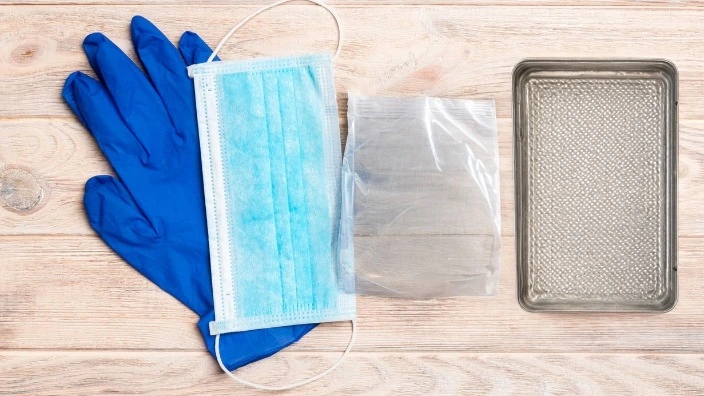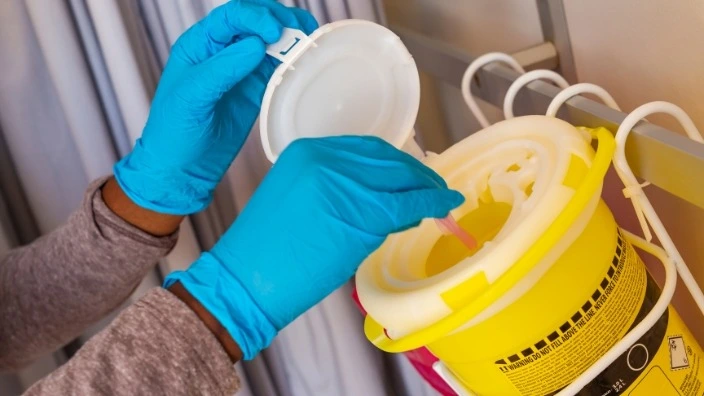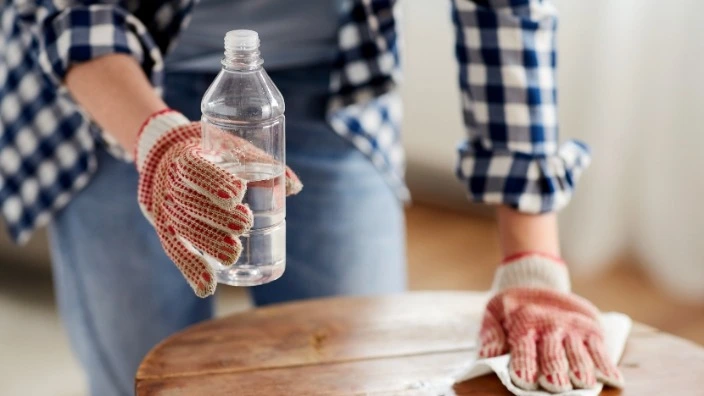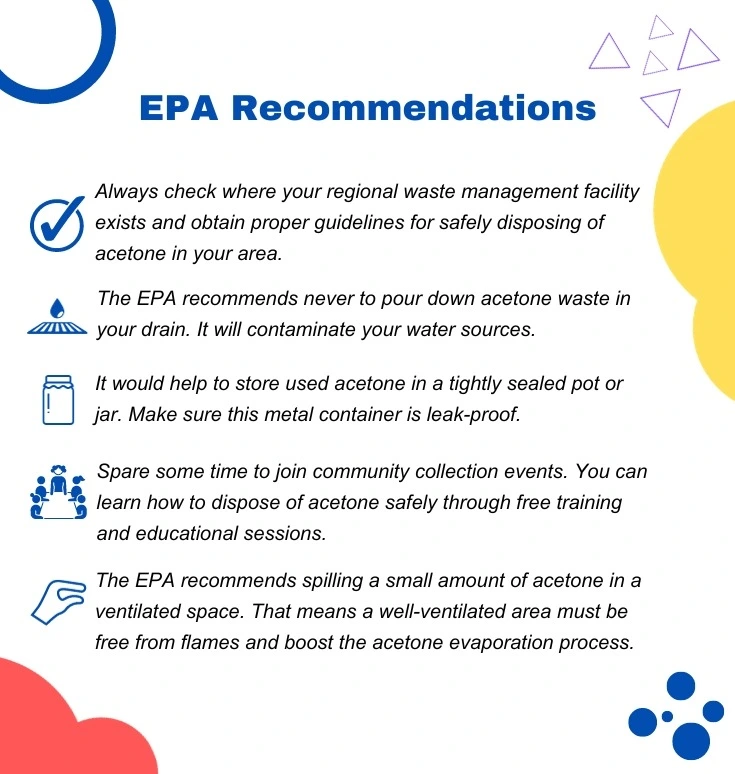Acetone is a versatile and multifaceted solvent. Its non-toxic properties make it a great product for personal use but utmost care is required to deal with the products. Since acetone is a clear volatile liquid and a good adhesive agent, you can use it at home for various purposes but at the same time you must know how to dispose of acetone.
The fact remains that only a few people know how to dispose of acetone safely. Although acetone can be used for many purposes explained in our article How to Get Fiberglass Out of Clothes; but still there is a need to raise awareness on the manner of disposing of acetone so to avoid it spreading and hazard effects.
Table of Contents
- The Significance
- Composition of Acetone
- What are the Uses of Acetone?
- Whether Exposure to Acetone Dangerous to Health?
- Whether you are disposing of acetone wrongly?
- Materials needed to remove acetone safely?
- What are the safe forms of throwing away acetone?
- Post disposal tips and EPA’s recommendation
- Post-advantages of safe Ejection of acetone
- Violations & Penalties
- Conclusion
- FREQUENTLY ASKED QUESTIONS
The Significance
It has been observed that if the acetone like material is not disposed of safely without undergoing the due care; one can suffer to face skin cracking, eye irritation, headache, vomiting, and other medical issues including skin problems.
To resolve the medical issues, we have made an effort share key methods so you people can avoid affecting from the hazardous acetone.
Composition of Acetone
“Acetone is an artificial chemical; which is also found naturally in the environment”. Some people know that trees, plants, and microorganisms also naturally produce acetone, yet most people believe that it's a manmade product.
As it is a colorless solvent with chemical formula (CH3)2CO; it tastes and smells awful and also evaporates quickly in the fresh air. On the other side, it also dissolves easily in water. This means humans can benefit from it by producing skin care, plastic, and other products.
As far as the composition of these dangerous chemicasl is concerned; “Acetone comprises elements such as acetone, hydrogen, oxygen, and carbon”. These are enough to make them a highly inflammable chemicals.
What are the Uses of Acetone?
The positive role of the acetone solvent in industries cannot be denied. Textiles, cosmetics, plastics, auto, and many other industries benefit from the acetone. Clean coins with acetone, so acetone cleaner can be used for cleaning coins.
We have explored that acetone is a necessary but a dangerous product. Though acetone is used for multiple purposes i.e. acetone nail polish remover is famous. Users must follow the proper protocols to avoid any unwanted condition; however, the troubling part is that many individuals either dispose of it unsafely or drop it in their toilets, which gets spread.
Whether Exposure to Acetone Dangerous to Health?
It has been learnt that individuals, homemakers, and factory workers use acetone during manufacturing and household cleaning. For example, beauty experts consume it at beauty and nail salons to increase their results and performance. They use nail lacquer to give a lustrous look to nail.

Needless to mention its exposure to individuals at the workplace helps acetone to enter into their lungs by the way of breathing air. Once the acetone is inhaled or dropped on any part of the body, it may enter your eyes, skin, and lungs and could cause serious havoc.
However, pouring acetone of small amount affects your body, there is nothing to worry about as your liver breaks it down into harmless chemicals.
People unaware of the reaction often use hydrogen peroxide (H2O2) to remove acetone but pouring acetone in hydrogen peroxide produces dangerous peroxides.
However, WebMD reveals that if you breathe or swallow a significant amount of acetone, it can lead to health problems such as: -
- Headaches
- Stress and confusion
- Dizziness
- Reducing the size of blood cells
- Eyes irritation
- Lung pain
- Flaky nails
- Kidney defects
Finally, discussing what acetone exposure does to women’s nails can be a woe-destruction moment for them.
Many females never realize how damaging the impact of acetone nail polish remover is until they see cuticles drying around their nails. This obnoxious chemical can dry, redden, and discolor their nails.
Whether you are disposing of acetone wrongly?
We discussed the significance of disposing of acetone in the right way because it could cause damage to your health and also the nearby locality members. So let’s mention the common mistakes we commit while disposing of acetone: -
- Exposing acetone jointly with other waste products
- Not putting the acetone in separate garbage bags
- Making no effort and just throwing acetone in the toilet or kitchen drain
- Disposing it off alongside other flammable products taht catch open flame
- Seeping it into earth’s soil like a pouring rain
Learning to remove acetone safely is very beneficial for you and also helpful for the community at large. In the severe conditions you may call local fire department. Having learnt the key methods to eliminate acetone; it is believed that you and your family will make every endeavor to throw away acetone fumes without destroying the environment and preventing health issues from arising.
Materials needed to remove acetone safely?
The quantity of acetone you are disposing of at home may be small but even then you are supposed to follow safety rules for disposing of acetone waste harmlessly.
It must be in your mind that you are dealing with a risky situation here. It is not a good idea to throw away acetone just after one use, reuse acetone but cautions.

Here are some of our BEST safety measures you can take while disposing acetone at home;
“A pair of safety gloves or rubber cleaning gloves good face mask, an empty garbage bag or a plastic bag, a hermetic metal container or vessel, Compliance with the safety items list”.
What are the safe forms of throwing away acetone?
While keeping the above stuff in hand, one can proceed to safely acetone disposal by applying the following tested methods: -
- Safe disposal of acetone cleaning products
- Careful disposal of acetone paint thinner
- Safely discard acetone leftover mess
These methods will work perfectly to destroy acetone safely from your home and the processes do not require any huge cost or a high level of effort. Let’s discuss in some detail the given method by referring to their attributes and the step-wise procedure: -
Safe Dispose off Acetone Cleaning Products
Although a small amount of acetone is not treated as environmentally hazardous, there is a need to raise awareness at home to dispose of the cleaning products safely by applying safety precautions. Most household individuals and working women use acetone with cotton balls.

However, to get rid of the acetone; it is recommended “to take a garbage bag and put those cotton swabs in that garbage bag”. Now make sure you tie the bag perfectly and put it in recycling facility center.
Conversely, putting acetone waste or nail polish remover in regular house trash is always an easy move. However, one thing you should not compromise is to properly wash your hands after touching those chemically bizarre cotton swabs. In case you consider those dirty cotton balls soaked in much acetone, squeeze them to get rid of them.
That will remove the extra acetone waste or nail polish remover from them; you can simply throw them into a sealable container and seal it tightly to prevent any kind of leakage.
Finally, you can take that waste fireproof container to a nearby recycling center. The work is done and by using the given method you have disposed of acetone-related products.
Safe Discarding of Acetone Paint Thinner
Paint thinners are also nasty; therefore it is advised to wear safety gloves or latex gloves before disposing of the paint thinner. To avoid the smell and inhaling of its particles, it is also recommended to wear a mask, wear gloves and enhance your safety while disposing of acetone related leftover paint thinner.

This strategy is vital for protecting your face from the fumes of acetone. Use a coffee filters in your kitchen and strain the paint thinner. Make sure you put it in a sealable jar. Tightly close the jar’s lid and seal it. Wait for some time till the paint dries in your coffee filter.
Take a paper product or an old newspaper; dispose of the paper in your trash can. Another strategy to get rid of such acetone is to locate a nearby hazardous waste disposal service using dedicated websites and contact them to know their rules for dropping off acetone.
Safe disposal of the leftover mess
This part discusses disposing of acetone safely by ensuring the safe elimination of the leftover acetone. For instance, this includes removing nail polish or handling nail polish remover.

It is recommended “to separate the used nail polish remover bottles from unused ones” rather than use a separate sealed container for them. Then, move to find a local hazardous material recycling facility agency and forward the container to them.
Post disposal tips and EPA’s recommendation
You should always refrain from disposing of acetone in the drain to avoid its spreading. It is advisable to store these used items away from any combustible product in your beauty salon or make-up room. You can also opt to find websites of the local recycling service to seek their help in getting rid of your woes and call them at your location.
The Environmental Protection Agency (EPA) has also provided some guidelines about “proper disposal of acetone at home”. However, only some people follow these local regulations to ensure the safe disposal of acetone.
Depending on your state and city, you can also follow the local guidelines to ensure safe hazardous waste disposal, however, the key guidelines are inter alia: -

Post-advantages of safe Ejection of acetone
There are many benefits to disposing of acetone however the notable benefits are as follows:-
- You helped save the environment and also the lab from acetone contamination.
- You have avoided the wrong practices of draining acetone into toilets.
- Besides, the environment, you also saved the environment, water supply, and soil from causing harm to humans and plants.
- You also avoided the threat of a fire explosion.
Violations & Penalties
It has been authorized by EPA regulators to impose fines on account of non-compliance with the waste regulations of acetone and “the amount of fine can go up to 37500 USD per violation for one day”.
The quantum of fines imposed by the EPA is higher than any other federal agency. In addition to the given fines, the waste generators are also held liable for the costs likely to be incurred on the disposal of their waste.
Conclusion
If you discard acetone safely it will avoid severe health issues and environmental woes. In the article, an effort has been made to let you know how to dispose off acetone or recycle it with our well-tested tips and strategies. The benefit of implementing the given patterns and strategies is will set a great example for others to dump acetone waste safely.
Moreover, you can also peruse and consult local regulations and learn area-specific acetone disposal strategies to avoid any repercussions from the administration side. Thus, you have the power to protect your community and the environment by applying safe techniques to dispose of hazardous substance and products.
We expect you won’t see any blocked drains or contaminated water in your area by following our strategies to throw out acetone waste. The benefits don’t end here. This post aims to spark a fire in you to improve your health and environment.
FREQUENTLY ASKED QUESTIONS
Is it OK to pour acetone down the drain?
No, you should not pour acetone in the drain or the toilet rather put that in a separate garbage bag to avoid its interaction with other waste materials.
How should acetone be disposed of?
It should either be disposed of by dropping the acetone at a hazardous waste management facility or by asking them to pick that up from your geographical location.
Where useless acetone products may be shifted?
Useless acetone products may be shifted to the nearby hazardous waste facility on your own or by using their services but remember to put them in a perfectly sealed form to avoid any form of leakage.


















